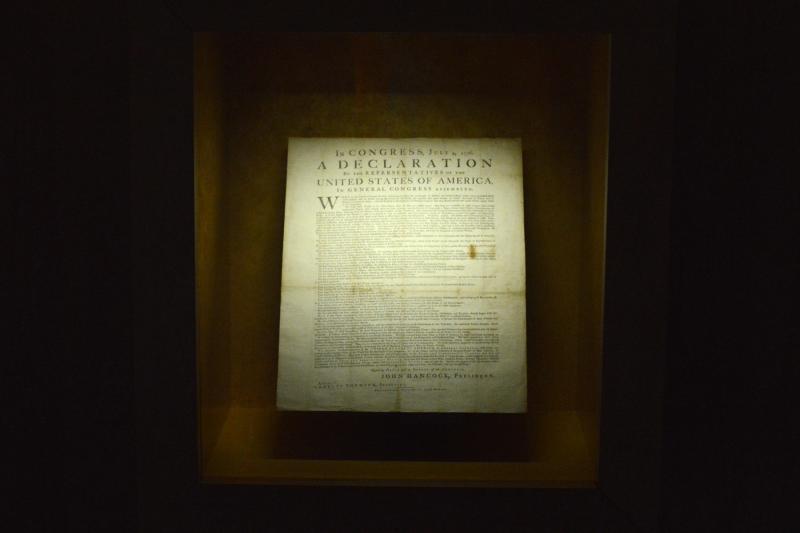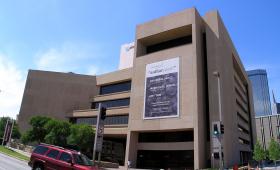How The 'Lost Copy' Of The Declaration Of Independence Landed In The Dallas Library
There’s a rare piece of American history tucked into the Dallas Public Library -- an original print of the Declaration of Independence. It's the only copy on display west of the Mississippi River.
On the seventh floor of the J. Erik Jonsson Central Library in downtown, in a dark room around the corner from the Texas History Division, the centuries-old document seems to glow within its glass display case.
“This is the first time the words ‘The United States of America’ appeared in print,” says Jo Guidice, director of the Dallas Public Library.
On the night of July 4, 1776, Thomas Jefferson visited a printer named John Dunlap and asked him to commit treason by printing about 200 copies of the Declaration. Of the 26 known to exist today, 23 are in the United States.
“One of them is in Texas. All of the rest are on the East coast," Guidice says.
Lost, then found in a Philadelphia book store
The official Declaration was based on one of Dunlap's prints, which were sent to colonial legislatures, committees of safety and armies to declare freedom from British rule. The Declaration wasn’t signed until Aug. 2, 1776.
“These were hand-printed, so every single letter was a wooden piece hand set by John Dunlap," Guidice says. "When you compare them, some of the punctuation changes and there are actually some words missing in the existing documents."
The copy that lives in Dallas is a complete document. All the words are accounted for, she says.
This print didn’t surface until 1968, when it was found boxed up in a closed-down Philadelphia bookstore.
“It was the ‘lost copy’ of the Declaration of Independence," Guidice says.
Soon after being found, it was auctioned off for more than $400,000.
The highest bidders? A pair of Dallas business executives: Joseph Driscoll and Ira Corn, Jr. They put the print on a nationwide tour.
Its new home: City Hall or the Library?
In 1982, with the help of 15 additional donors, the city of Dallas acquired the document.
It was first on display at Dallas City Hall. George Schrader, who was city manager at the time, wanted it to stay there.
Library Director Lillian Bradshaw argued for a different home.
“She was a very distinguished librarian. She had a good case for it and it prevailed," Schrader says.
And now even Schrader is on board.
"I can’t fault the decision at all,” he says.
Thousands of students have filed past the copy of the Declaration on class field trips.
The Declaration represents this country’s ideals, Schrader says. And the library is a good home for it, he says. He's glad a copy resides in Dallas.
“It is not going to perish. It’s going to be around. And it’s free. And it brings to people who otherwise wouldn’t have access an enormous amount of information and services," Schrader says of the library. "It is, and maybe this is something that I want it to be, it’s the corporate memory of this community.”
The opening lines of the Declaration of Independence
When in the Course of human events, it becomes necessary for one people to dissolve the political bands which have connected them with another, and to assume among the powers of the earth, the separate and equal station to which the Laws of Nature and of Nature's God entitle them, a decent respect to the opinions of mankind requires that they should declare the causes which impel them to the separation.
We hold these truths to be self-evident, that all men are created equal, that they are endowed by their Creator with certain unalienable Rights, that among these are Life, Liberty and the pursuit of Happiness.--That to secure these rights, Governments are instituted among Men, deriving their just powers from the consent of the governed, --That whenever any Form of Government becomes destructive of these ends, it is the Right of the People to alter or to abolish it, and to institute new Government, laying its foundation on such principles and organizing its powers in such form, as to them shall seem most likely to effect their Safety and Happiness.
Learn more
The New York Times: A Period Is Questioned In The Declaration Of Independence
The Washington Post: What You Know About July 4th Is Wrong
Archive Photo Credit: Michael Hartford/Flickr



No comments:
Post a Comment